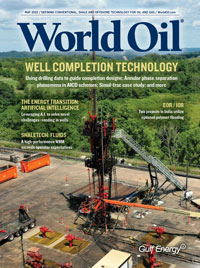Issue: May 2022
Special Focus: Well Completion Technology
Existing but previously unused data obtained during the drilling process can now be used to enhance completion design. The author outlines the available data and discusses how it can be incorporated into the completion design process and ultimately provide economic benefits to an operator.
AICDs are the next generation of inflow control technology that autonomously provides a more uniform inflow profile and enhanced production. The FloSure AICD increases oil output over field life and has been deployed successfully in light and heavy oil wells to overcome water
or gas breakthrough.
Efficiency gains are required to enhance completion performance, to promote maximum hydrocarbon recovery. New pressure pumping advances are helping service companies to be more competitive while improving profits for operators.
Smart tracers to map injection flow, promote inter-well communication as prelude to full-field development.
Features
Over the past decade, a subsea provider has been growing its decommissioning capabilities across the North Sea. In a project for Repsol Sinopec Resources, it achieved a 99% repurpose/recycle rate.
A high-performance WBM, with an innovative polymer chemistry, is exceeding operator expectations in reducing operational time and expense, compared to NAF.
A domain-centric approach when applying AI technologies is being used to solve issues in challenging wells.
The year 2022 in Washington, D.C., is no different, where energy is concerned, than any other year, as politicians create new problems on top of old ones.
Polymer flooding actually dates back to the 1970s and 1980s, but it is enjoying a resurgence of usage, thanks to more recent results in projects.
Columns
Evelyn MacLean, workforce energy task force director of the UK-based International Association of Oil and Gas Producers, says it’s time technology advancements are coupled with a re-examination of the workforce relationship.
Amidst the crush of energy, financial and wartime news, you might have missed a significant milestone within Russia’s oil and gas industry. On April 21, now-former Lukoil CEO Vagit Alekperov resigned from that company.
The dire predictions by executives and consulting firms about the short-term/long-term effects of Covid-19 on the industry were overwhelming. The unrelenting onslaught of “we will never recover” or “nothing will ever be the same” seemed short-sighted.
Operators continue to look for field solutions that bring greater efficiencies and cost-savings. With these concerns top of mind, we recently introduced our more streamlined SPM™ Simplified Frac Iron System.
We all agree that the goal is to desalinate produced water to the point it can be reused beneficially, but there are many potential uses, each with its own inherent treatment requirements.
Exploration has been occurring ever since the first family of upright humans asked “what’s over there,” deciding to move to greener ground.
Resources
Despite restricted Russian supply, due to the war in Ukraine, crude prices slipped in April. WTI dropped 6.2% to $101.78/bbl, with Brent trading at $101.78/bbl, down 13.2% compared to March. Despite lower prices, U.S. operators finally started ramping up drilling activity, which is typically the case in a high-price environment.



